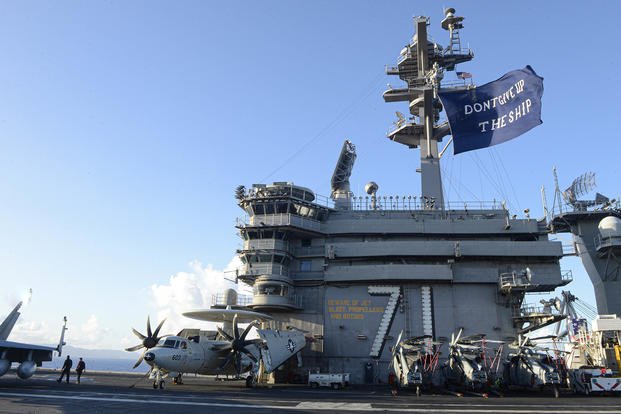When it comes to national pride, there's nothing more American than baseball and apple pie -- and, in the case of the U.S. Navy, the intimidating sight of a battle flag flapping in the wind.
Battle flags have been a fixture of the Navy since the earliest days of the Revolutionary War, when Continental Army Gen. George Washington in October 1775 commissioned a half-dozen frigates flying white flags featuring a green pine tree and the slogan "An Appeal to Heaven" emblazoned across the bottom. Since World War II, naval battle ensigns have traditionally flown while a warship is entering or exiting a friendly port, during exercises or during "special ship evolutions" such as holidays. Regardless of the circumstances, battle flags are a welcome sight to most naval observers, markers of the history and heritage that define each American warship as it sails into the vastness of the world's oceans.
Below, you'll find an alphabetical guide to some of the best-known modern Navy battle flags. Because the Navy has no comprehensive database of battle flags, this list was compiled based on images in the Defense Visual Information Distribution Service (DVIDS), social media and other online repositories.
Don't see your ship's battle flag here? Did we get some details wrong? Send a note to jared.keller@military.com with recommendations and help expand our list.
USS Abraham Lincoln

The Nimitz-class aircraft carrier USS Abraham Lincoln’s battle flag is relatively simple, featuring an image of President Lincoln’s face superimposed in white against a blue background and the words "Lincoln Nation" running vertically against an orange stripe alone the base of the banner. Beneath Lincoln’s face are the words “shall not perish” in white, a reference to his closing line from the Gettysburg Address: “That we here highly resolve that these dead shall not have died in vain -- that this nation, under God, shall have a new birth of freedom -- and that government of the people, by the people, for the people, shall not perish from the earth."
USS America

Of all the battle flags in the U.S. Navy, the USS America's may be among the most patriotic. The service's lead America-class amphibious assault ship, the America was spotted flying a blue flag emblazoned with the iconic shield of legendary Marvel Comics character Captain America during an exercise with the Royal Thai Navy in the Gulf of Thailand in February 2020. Although it's unclear when the America, which was commissioned in 2014, began flying the battle flag, it was spotted flying from the ship's island superstructure as early as 2019 while arriving in Sasebo, Japan, according to DVIDS.
USS Anzio
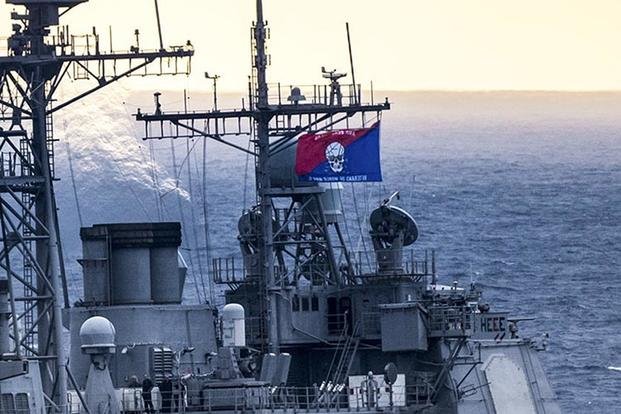
Named for the beachhead invasion of Italy by Allied troops during World War II, the Ticonderoga-class guided missile cruiser USS Anzio flies what's known as the Anzio Beachhead Flag, which features a map of the Anzio beachhead overlaid on a white skull against a red-and-blue background with "Veterans of World War II" emblazoned below it. According to the Navy, the skull represents Nazi leader Adolf Hitler's promise to "turn the Anzio beach head into 'death's head,'" while the diagonal line dividing the red and blue fields represents the "Gustav Line" that divided occupied Italy. The blue, representing the ocean, is filled with sunken aircraft and warships, which represents "that massive loss of these American, British, and Canadian assets of war" during the invasion, which claimed the lives of more than 28,000 Allied service members.
USS Bataan

The Wasp-class amphibious assault ship USS Bataan is named to commemorate the valiant resistance of U.S. and Filipino troops to Japanese forces on the Bataan Peninsula from December 1941 to April 1942, according to the Navy. The Bataan’s battle flag consists of the number 5 emblazoned in white across a red field with the words “Battling Bastards” -– a tribute to the “Battling Bastards of Bataan” -– above it. The red field represents courage and sacrifice, while the white letters denote integrity, per the service.
USS Benfold
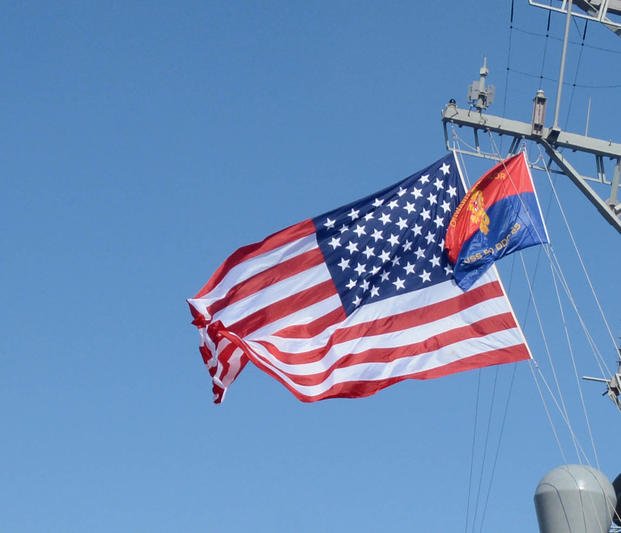
Named for Navy hospital corpsman third class Edward Clyde Benfold, who was killed in action during the Korean War in 1952 and posthumously awarded the Medal of Honor, the Arleigh Burke-class destroyer USS Benfold boasts a relatively simple battle flag. The battle ensign features a golden lion with a red cross on a white shield against a red-above-blue background and the ship's motto "Onward With Valor" emblazoned across the top. The lion "embodies valor and strength, symbolizing Hospitalman Benfold's courage and gallantry," according to the Navy, while the red cross and white shield represent Benfold's "medical service and personal sacrifice in saving the lives of others."
USS Bunker Hill
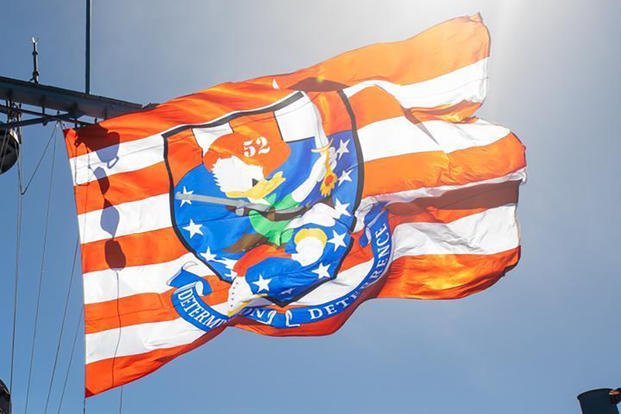
It's unclear exactly how a Disney character ended up on the battle flag of the Ticonderoga-class guided missile cruiser USS Bunker Hill. The ship's flag features what appears to be Donald Duck decked out in Revolutionary War gear on a field of red and white stripes with the ship's motto of "Determination, Deterrence" emblazoned beneath it. The Donald Duck pattern has been a fixture of the Bunker Hill since at least World War II, when the name belonged to an Essex-class aircraft carrier that saw action in the South Pacific.
USS Carl M Levin
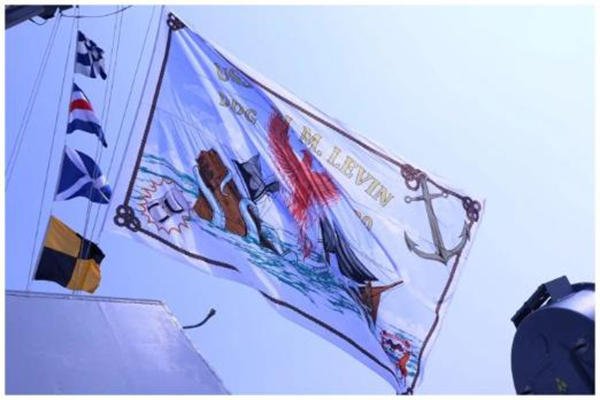
One of the newest Arleigh Burke-class destroyers to join the fleet, the USS Carl M. Levin's battle flag was designed with one purpose in mind: to be "badass." Named for the late Michigan senator, the Levin's battle flag was designed by one of the ship's crew and portrays a mythical kraken sea creature splitting a pirate ship into two pieces as a phoenix rises over the wreck. Levin's service in Congress is represented by an ivory gavel in the flag's lower left corner, while the Michigan flag appears in the lower right-hand corner as a tribute to the late senator's home state.
USS Carney
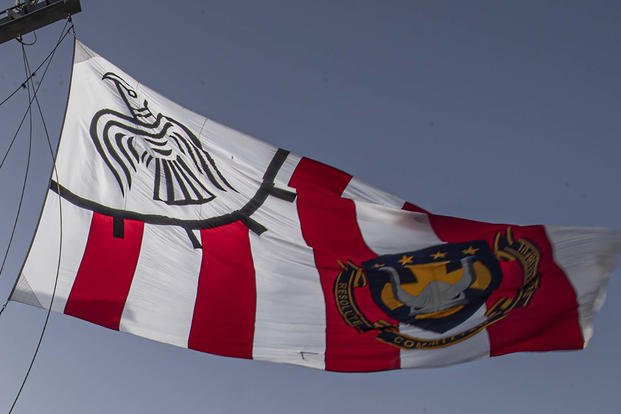
Named for Adm. Robert Carney, the chief of naval operations under President Dwight D. Eisenhower, the Arleigh Burke-class destroyer's battle flag features the ship's crest on a field of vertical white and red stripes. The Viking helmet overlaid on a gold cross is meant to represent "ancestral Viking and Celtic ferocity in combat," and the Navy Cross that Carney earned during the Battle of Leyte Gulf in World War II, respectively, according to the service. The origin of the bird in the upper left corner is unclear, but according to some observers, it's a Norse raven, which matches the other Norse symbolism apparent in the Carney's crest.
USS Chafee
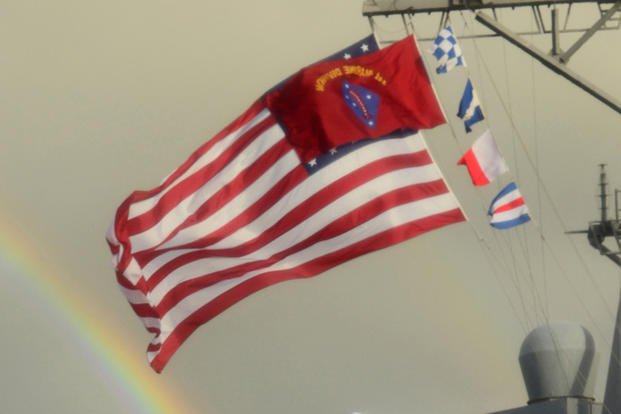
The USS Chafee's battle flag is one of many in the fleet that pays tribute to a particular unit. The Arleigh Burke-class destroyer's battle ensign features the divisional insignia of the 1st Marine Division emblazoned across a red field, an homage to the oldest and largest active-duty division in the Corps and the very unit to which the ship's namesake, former senator and Navy Secretary John Chafee, belonged to when he fought on the island of Guadalcanal during World War II.
USS Cole
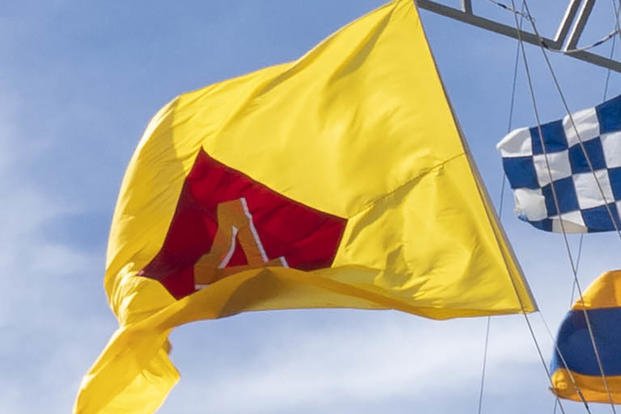
The USS Cole's battle flag, like the Chafee's, is a simple design meant to pay tribute to its namesake's unit. A yellow number four inside a red diamond against a yellow background, the flag is a homage to the company flag of Marine Sgt. Darrell Cole, a member of the Fourth Marine Division who posthumously received the Medal of Honor for his valor and gallantry during the Battle of Iwo Jima in World War II, according to one of the ship's sailors.
USS Chung-Hoon
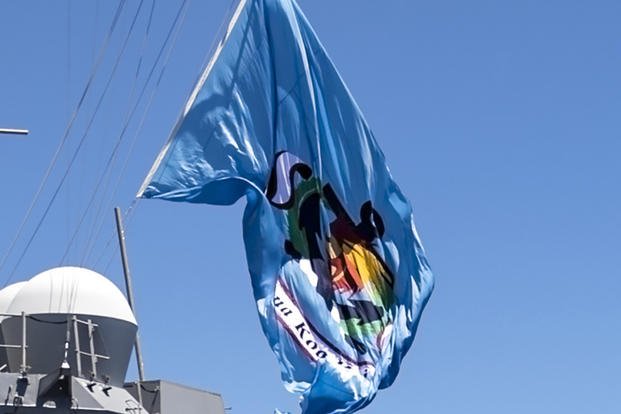
Named for the legendary late Rear Adm. Gordon Paiʻea Chung-Hoon, a Navy Cross and Silver Star recipient and the service's first Asian-American flag officer, the USS Chung-Hoon's battle flag is designed to embody its namesake's Hawaiian heritage. It features the Arleigh Burke-class destroyer's crest -- a Hawaiian warrior helmet that "emphasizes the fighting spirit" of the ship and anchor wrapped in palm wreaths that "symbolize[s] victory and the triumph of the human spirit," according to the Navy -- against a light blue background, with the ship's motto of "Imua e na Koa Kai" (Hawaiian for "Go Forward Sea Warriors") emblazoned beneath it.
USS Curtis Wilbur

Named for the 43rd secretary of the Navy, the Arleigh Burke-class destroyer USS Curtis Wilbus features the ship’s motto twice, with “Prudens Potens Patria” below the silhouette of an eagle and its English translation, “Judicious Power for Country,” in red above it against a black field with a yellow border.
USS Daniel Inouye
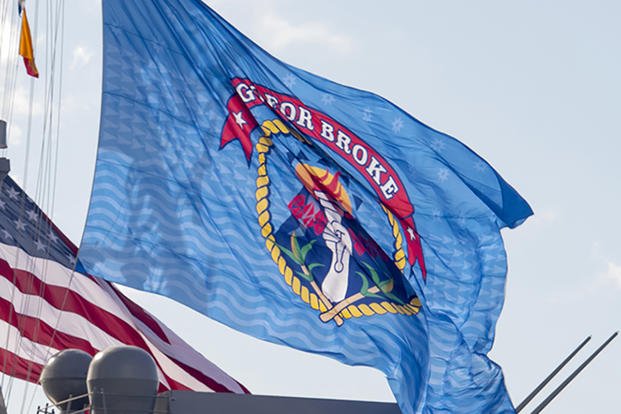
The USS Daniel Inouye is named for the late Hawaii Sen. Daniel K. Inouye, an Army veteran, World War II Medal of Honor recipient and the first Japanese-American elected to Congress. The Arleigh Burke-class destroyer's battle flag features a hand grasping a torch and the motto "Go For Broke," both of which are meant as a tribute to the decorated 442nd Regimental Combat Team, with which Inouye served. The flag's vibrant blue background also incorporates "authentic 'ohe kapala (bamboo stamping pattern) designed for us by a Native Hawaiian artist," according to the Daniel K. Inouye Institute's website.
USS Decatur
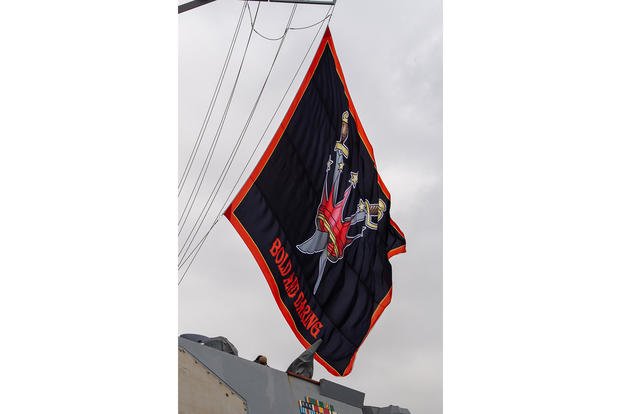
The Arleigh Burke-class destroyer, named for legendary Revolutionary War naval officer Commodore Stephen Decatur, features a perfect battle flag to honor its swashbuckling namesake: a pair of crossed swords and a red crown with the words "Bold and Daring" emblazoned across the bottom. According to a Navy spokesman, the red crown symbolizes the ship's anti-air warfare capabilities, while the five stars above it represent the five ships that once bore Decatur's name. As for "bold and daring": They are the exact same words British Royal Navy Adm. Horatio Nelson used to describe Commodore Decatur's legendary 1804 raid on the U.S. Navy frigate Philadelphia in Tripoli.
USS Dewey
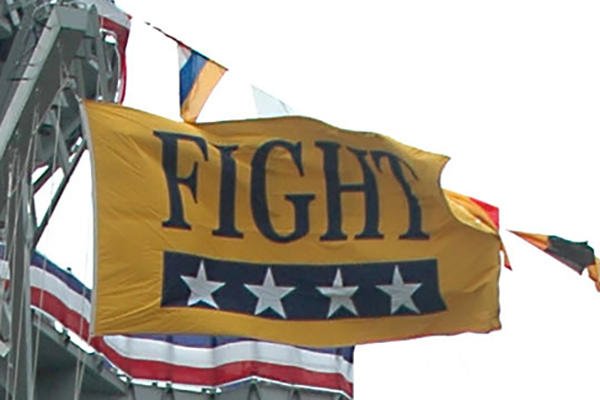
The USS Dewey's flag is simple, featuring the word "Fight" in blue emblazoned across a yellow field with four white stars inside a blue stripe beneath it. The "fight" in the Arleigh Burke-class destroyer's battle flag is a reference to the ship's slogan of "Dynamis Ex Cardias," or "The Will to Fight from the Heart," while the four stars are a reference to namesake Adm. George Dewey's status as the first Navy admiral to hold the rank of "Admiral of the Navy," the highest possible rank in the service (which uses four-star symbology despite its equivalent to at least a five-star role).
USS George HW Bush
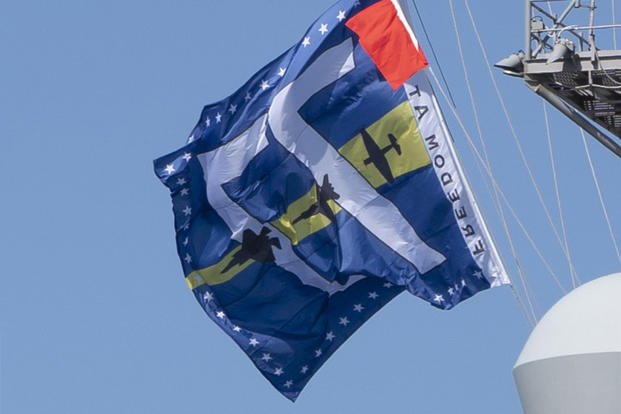
The aircraft carrier USS George HW Bush's battle flag pays tribute to both the late president and the history of naval aviation. The ensign is bordered with what appears to be a ring of 41 stars for Bush's time as the United States' 41st president, with a white "77” dead center to note the warship's hull classification of CVN-77 and featuring the motto "Freedom at Work” along the flag's edge, a reference to Bush's 1989 inaugural speech, per Task & Purpose. The flag also features three aircraft against a yellow path in the flag's center to represent the "past, present, and future" of naval aviation: a TBM Avenger bomber (which Bush operated during World War II), an F/A-18 Hornet fighter and the F-35C Lightning II.
USS George Washington
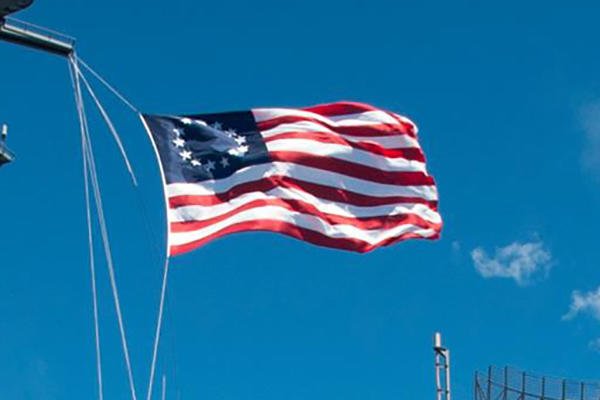
The aircraft carrier USS George Washington's battle flag is a fitting tribute to its namesake. The warship often flies the so-called "Betsy Ross flag," which features 13 white stars arranged in a blue field in the upper left corner contrasted against red and white stripes. It was among the first flags flown by the nascent United States of America during the Revolutionary War. While the Ross family claims that the seamstress created the first American flag for then-Gen. George Washington during the beginning of the war, the origins of the flag and Ross' relationship to Washington remained shrouded in mystery.
USS Gerald R Ford
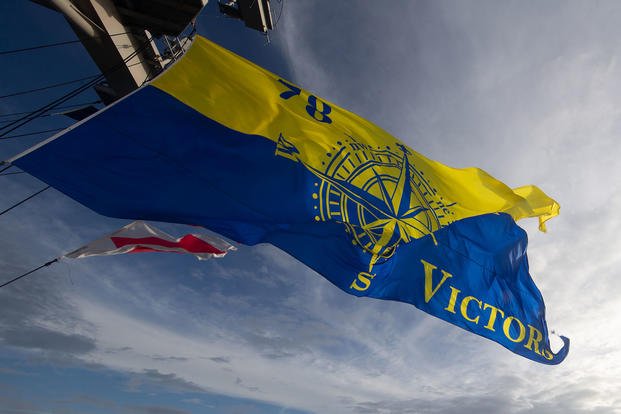
The newest and most advanced aircraft carrier in the Navy's fleet, the USS Gerald R Ford's battle flag, like most others, pays tribute to its namesake. The core blue and yellow color scheme represents the 38th president's undergraduate years at the University of Michigan, per Task & Purpose, while the nautical compass topped with a fleur-de-lis honors both Ford's service in the Navy during World War II and his "distinction as the only president who achieved the rank of Eagle Scout," according to the Gerald R. Ford Presidential Foundation. And while the ship's motto is "Integrity at the Helm," the flag merely reads "Victory" with a 78 to represent the carrier's hull classification of CVN-78.
USS Gonzalez
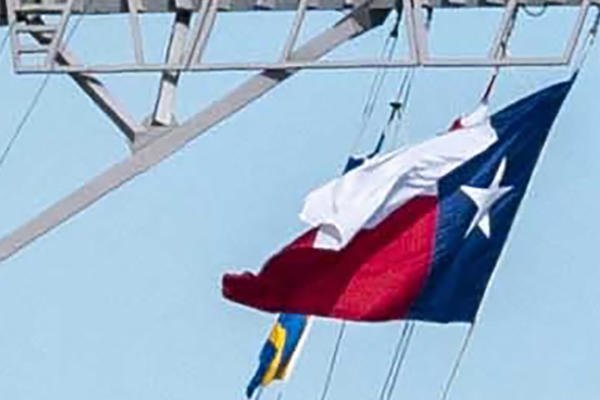
Despite the fact that the Arleigh Burke-class destroyer USS Gonzalez seems like the perfect candidate to fly the beloved "Come and Take It" cannon flag that came out of the Battle of Gonzalez, the ship's battle flag is simple instead. Named for Marine Sgt. Alfredo Cantu Gonzalez, a Medal of Honor recipient in the Vietnam War, the ship flies the flag of the state of Texas as a tribute to its namesake's home state -- an interesting choice given that Texas does not show up in the ship's crest whatsoever.
USS Gridley
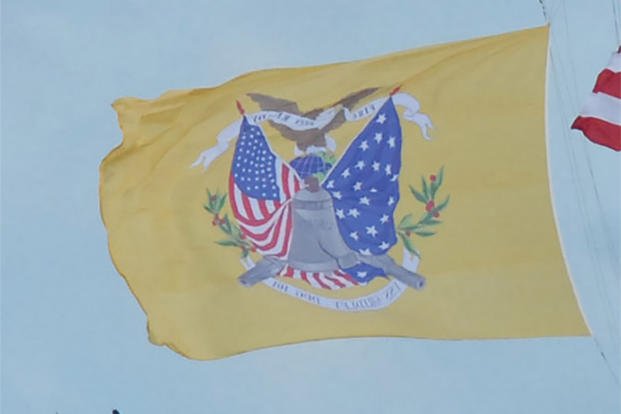
The Arleigh Burke-class destroyer USS Gridley's battle flag may not look like much at first glance, but it contains one of the most badass quotes in U.S. military history. Above the rendering of the cracked Liberty Bell flanked by the American flag and Jack of the United States rests a simple line of "fire when ready." The slogan is a clear tribute to the order "You may fire when ready, Gridley," which Adm. George Dewey gave to Capt. Charles Gridley in 1898 at Manilla Bay during the Spanish-American War, according to the Navy.
USS Harry S Truman
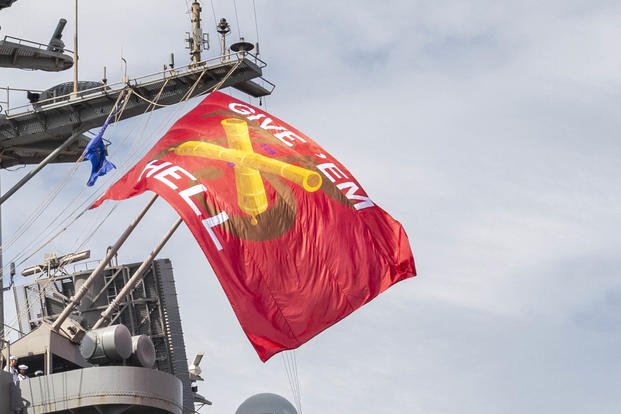
Like other battle ensigns, the aircraft carrier USS Harry Truman's battle flag is a clear tribute to its namesake's Army service. The flag is a modified version of the crossed cannon flag carried by the 129th Field Artillery Regiment, 35th Division, whose D battery Truman commanded during World War I, according to the USS Harry S. Truman Foundation. The flag’s scarlet background represents "the price Americans have paid for freedom" throughout the country's history. The "give 'em hell" motto, unfortunately, is not from Truman's World War I service but a tribute to a moment during his 1948 presidential reelection campaign when a particularly zealous supporter yelled "Give 'em hell, Harry'' at a campaign rally, per the foundation.
USS Howard
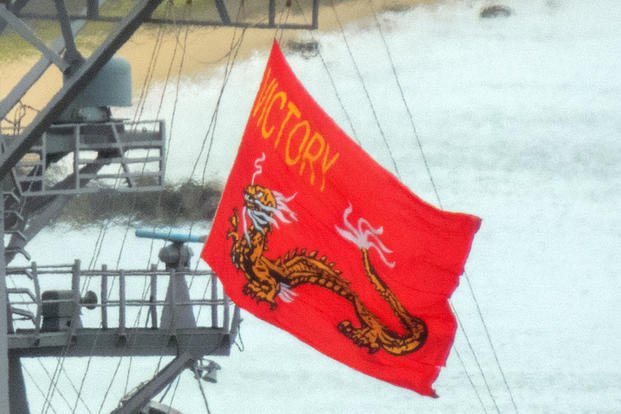
The Arleigh Burke-class destroyer USS Howard's battle flag is one of several across the fleet that features a mythical creature. The bright red flag features an Asian-style dragon emblazoned across it with the word "Victory" in yellow in the corner, the latter of which is a clear reference to the ship's motto of "Ready for Victory." The dragon itself, according to the Army's Institute of Heraldry, denotes service in the Pacific and the fighting spirit demonstrated by the platoon under the leadership" of the ship's namesake, Medal of Honor recipient Marine Corps First Sgt. Jimmie E. Howard.
USS John Finn
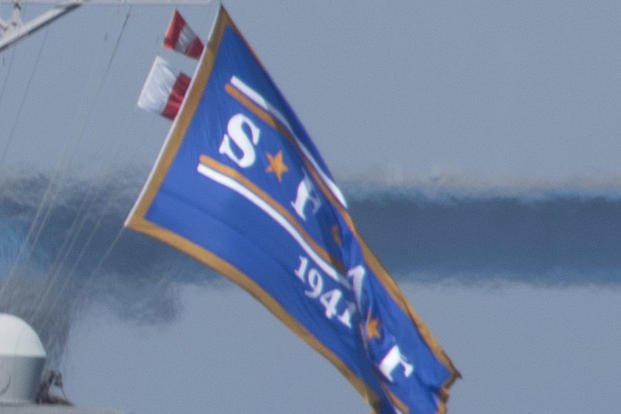
The Arleigh Burke-class destroyer USS John Finn is named for Chief Petty Officer John William Finn, who received the first Medal of Honor of World War II for fighting off Japanese warplanes during the attack on Pearl Harbor despite his injuries. The ship's battle flag features the initials "S.F.A.F,." which stands for the ship's motto of "Status Et Pugno," or "Stand Fast and Fight," while the number “1941” appears beneath the letters as a reminder of Finn's courage and gallantry during the surprise attack on Pearl Harbor.
USS John Paul Jones

The so-called “Serapis” flag flown by the Arleigh Burke-class destroyer USS John Paul Jones is steeped in history. Also known as the Franklin Flag, it was one of the first informal flags of the United States, first created in 1779 after Navy Capt. John Paul Jones captured the British frigate HMS Serapis and sailed it to a Dutch port.
Lacking an official ensign, Jones was forced to fashion an improvised flag to formally enter the port without being considered a pirate under maritime law, avoiding a potential diplomatic blowup and saving his life and those of his crew. The flag itself looks just like a classic Revolutionary War-era American flag, but with 13 alternating blue, red and white stripes and a blue canton with 13 stars.
USS John S McCain
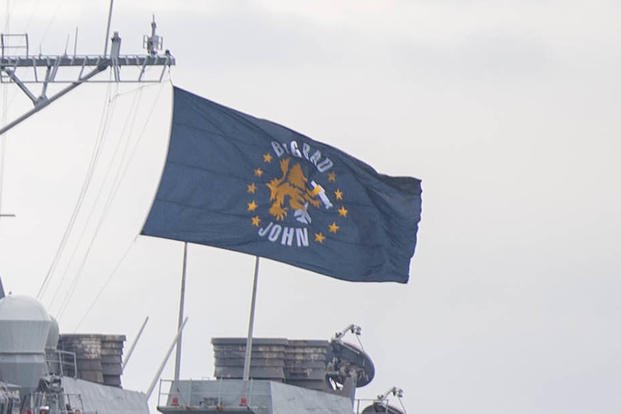
The USS John S. McCain was named for legendary Navy Adms. John S. McCain Sr. and John S. McCain Jr., who commanded an aircraft carrier and two submarines during World War II, respectively. The flag features the ship's nickname "Big Bad John" encircling a golden lion clutching a submarine and an aircraft with five stars on each side against a blue background. The symbolism of the stars, lion, sub and aircraft are unclear, as they do not appear on the ship's crest.
USS Kidd
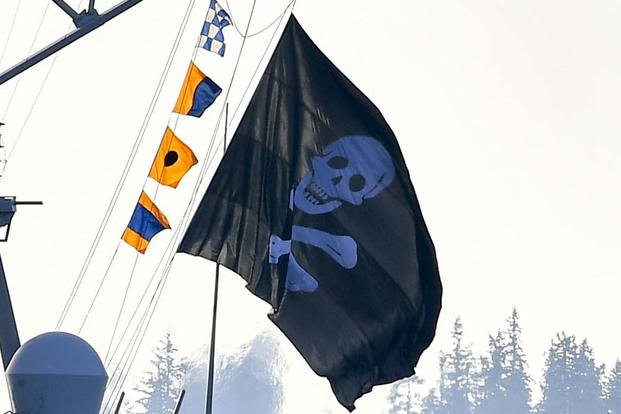
The USS Kidd's battle flag may be the simplest, yet most badass in the Navy. It’s named for Rear Adm. Isaac C. Kidd, the first American flag officer to die in World War II when he was killed aboard the USS Arizona during the Japanese attack on Pearl Harbor. The Arleigh Burke-class destroyer boasts a classic "Jolly Roger" pirate flag as its battle ensign, an honor for which Kidd's widow Inez explicitly lobbied the Navy when a Fletcher-class destroyer was named in honor of the admiral in 1943. While the Kidd isn't the only warship to ever fly the Jolly Roger, it's currently the only one in the Navy explicitly authorized to do so.
USS Laboon
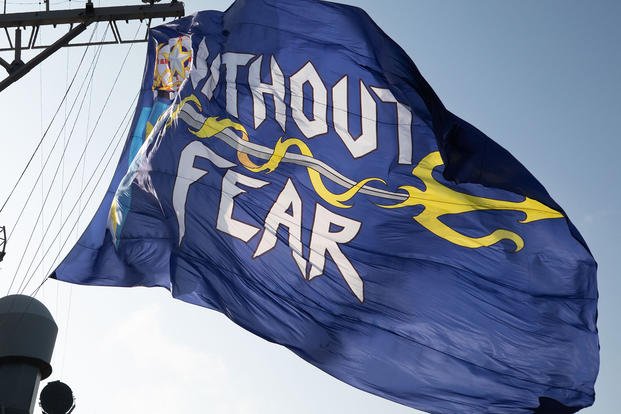
The Arleigh Burke-class destroyer USS Laboon's battle flag is relatively straightforward. Named for John Francis Laboon Jr., a World War II submariner and Vietnam War chaplain who swam through mine-filled waters to rescue a downed aviator, the warship's battle ensign consists of the ship's motto of "Without Fear" emblazoned in yellow above a trident. The trident is purportedly meant to represent the ship's vertical launch capabilities at sea, with the three tines representing "anti-submarine, anti-air, and anti-surface warfare," according to the Navy. The ship's motto is a tribute to Laboon's heroism. The service says: "Just as Capt. John Francis Laboon showed no fear in rescuing the downed aviator, [USS] Laboon meets all the challenges, milestones, and obstacles."
USS Lake Champlain
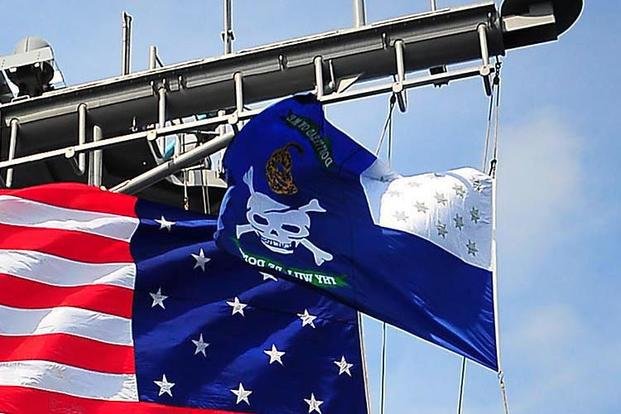
Decommissioned in September 2023 after 35 years of service, the Ticonderoga-class, guided-missile destroyer USS Champlain previously flew a variation of the "War of 1812" or "Battle of Plattsburgh" flag that commemorates the pivotal Battle of Lake Champlain during that conflict. The flag contains several delightful features, including a coiled snake with the traditional "Don't Tread on Me" language above it, and a skull and crossbones with "Thy Will Be Done" inscribed beneath it. The flag also features a field of 13 stars in the corner to represent the number of states in the Union at the time of the conflict.
USS Makin Island
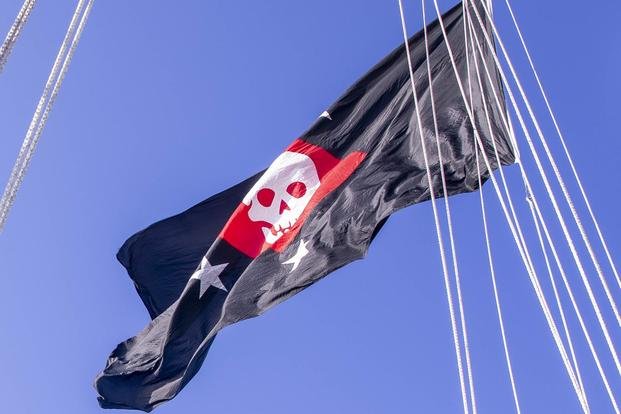
Named for the raid executed by Marine Raiders on Japanese-held Makin Island in August 1942, the Wasp-class amphibious assault ship USS Makin Island has been spotted flying the Marine Raider flag, with its battle ensign featuring a white skull in a red diamond surrounded by five white stars arrayed in a "southern cross" against a blue field. Interestingly, Marine Forces Special Operations Command has explicitly shied away from incorporating the iconic skull logo into its modern imagery, according to Marine Corps Times.
USS Mason
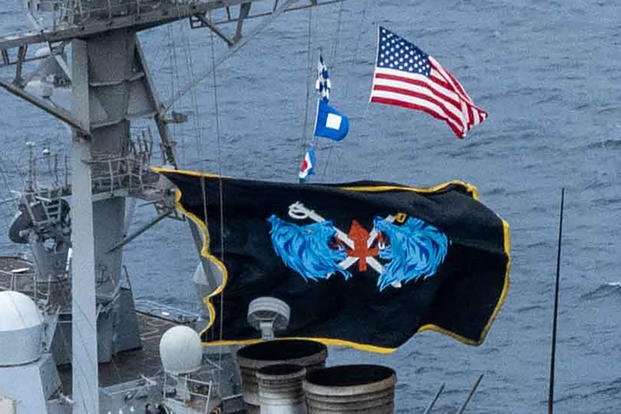
Named in honor of the primarily African American crew of the World War II destroyer escort USS Mason, the Arleigh Burke-class destroyer's battle ensign closely resembles the ship's crest, with two blue lion heads flanking a crossed sword and cutlass and a centered trident above the ship's motto of "Proudly We Serve." According to the Navy, the lions' heads represent the Pacific and Atlantic campaigns of WWII. The left-facing lion symbolizes "the service and sacrifice" of original USS Mason's namesake Ensign Newton Henry Mason in the Battle of the Coral Sea. The right-facing lion "symbolizes the crew's courageous actions in the North Atlantic during Convoy NY 119 in the ship bearing Ensign Mason's name." The trident symbolizes the modern Arleigh Burke class' suite of capabilities that contribute to its dominance at sea.
USS Michael Murphy

The Arleigh Burke-class destroyer USS Michael Murphy holds the distinct pleasure of flying two battle flags, often at the same time: a gargantuan American flag and a giant "bone frog” flag to commemorate its namesake, Medal of Honor recipient Navy SEAL Lt. Michael Murphy, according to The War Zone.
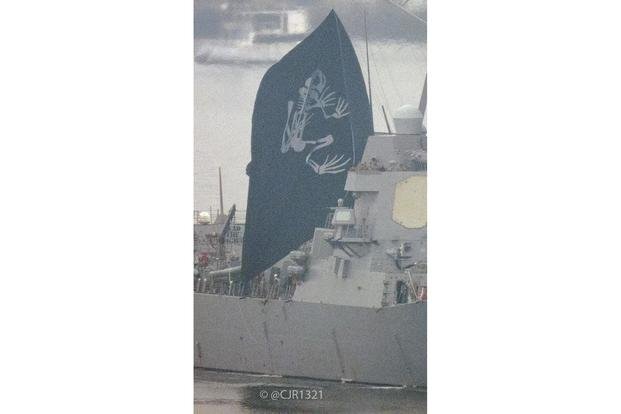
The bone frog is generally considered a symbol of Navy SEALs who have paid the ultimate price in the service of the nation, a title that applies to Lt. Murphy's heroic actions during 2005's Operation Red Wings during the War in Afghanistan.
USS Monterey
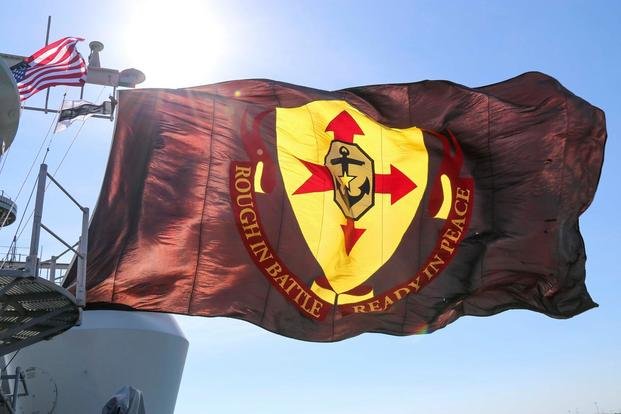
Decommissioned in 2022, the Ticonderoga-class guided missile destroyer was the fourth Navy warship named for the Battle of Monterey during the Mexican-American War. According to the Navy, the flag's central shield represents the Aegis, "the impenetrable defensive shield of the Greek god Zeus" that's the namesake of the Arleigh Burke-class destroyer's combat system. The red arrows stand in for the Navy's Surface Warfare logo, while the elongated octagon "is familiar to all who view the modern warship's sophisticated radar array" and the dark blue anchor represents "seapower, strength, and Navy tradition," according to the service.
USS Mount Whitney
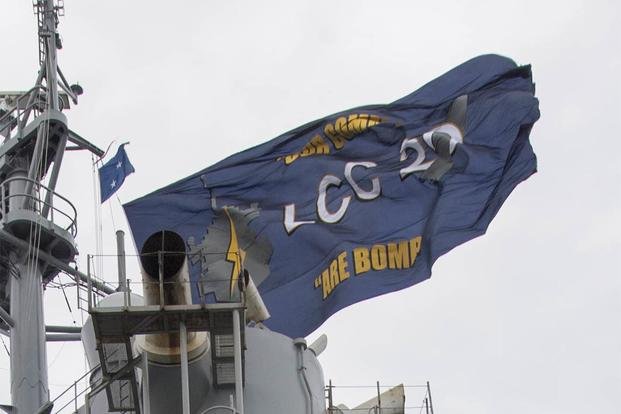
One of two Blue Ridge-class amphibious command ships in the Navy's fleet, the USS Mount Whitney is named for the highest summit in the contiguous United States. The ship's unofficial slogan, "Our Comms are Bombs," is emblazoned across the ship's battle flag instead of its official motto of "The Voice of The Sea," likely as a tribute to the ship's unique command and control capabilities.
USS Mustin

Named for the Mustin family of sailors that has fought in five wars over more than a century of service to the Navy, the Arleigh Burke-class destroyer's battle ensign features a series of four crossed naval officer swords and gold stars against a blue field with the ship's motto of "Toujours L'Audace" ("Always Be Bold") emblazoned across the bottom. According to the Navy, the four crossed swords symbolize "the commissioned service of each of the Mustins honored in the naming and commissioning" of the ship: "The Father of Naval Aviation," Capt. Henry C. Mustin; World War II-era Vice Adm. Lloyd M. Mustin; Vietnam War-era Vice Adm. Henry C. Mustin; and Lt. Cmdr. Thomas M. Mustin.
USS New York

The San Antonio-class amphibious transport dock USS New York’s battle flag is relatively simple: It’s the seal of New York state superimposed over a dark blue background, a color typically associated with the Navy. It’s the second major part of the vessel’s symbology dedicated to its namesake, as the ship’s crest pays tribute to the victims and first responders of the Sept. 11, 2001, terror attacks -- appropriate for a ship built from steel salvaged from the World Trade Center.
USS Nimitz
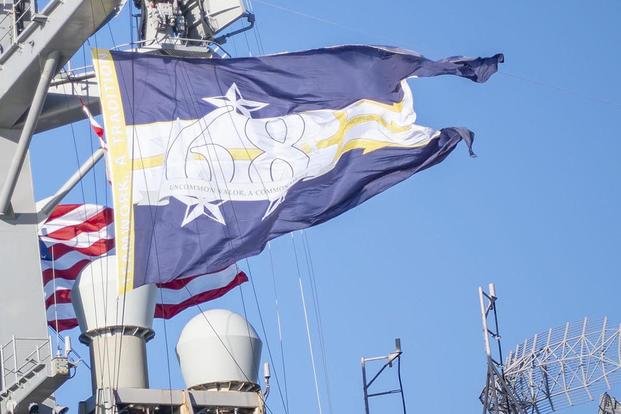
The Navy aircraft carrier USS Nimitz, named for World War II Pacific Fleet Commander Adm. Chester W. Nimitz, features a battle flag that honors the service of its namesake. The flag consists of a horizontal trident with labels on the three tines: "Ohio," for Nimitz's service aboard the battleship USS Ohio; "CINCPAC" for his role as commander in chief of the U.S. Pacific Fleet during World War II; and what appears to be "CNO" for his post-war service as chief of naval operations. The number 68 represents the carrier's hull number, while the five stars represent the rank of fleet admiral, which Nimitz was one of four Navy officers to achieve in the history of the service.
USS Nitze

The Arleigh Burke-class destroyer USS Nitze boasts an uncomplicated battle flag. Named for former Navy Secretary Paul Nitze, the battle ensign features a representation of an eagle with wings outstretched across a shield of stars and stripes against a dark blue background. The world "NITZE” appears emblazoned in green across the bottom of the flag.
USS Normandy
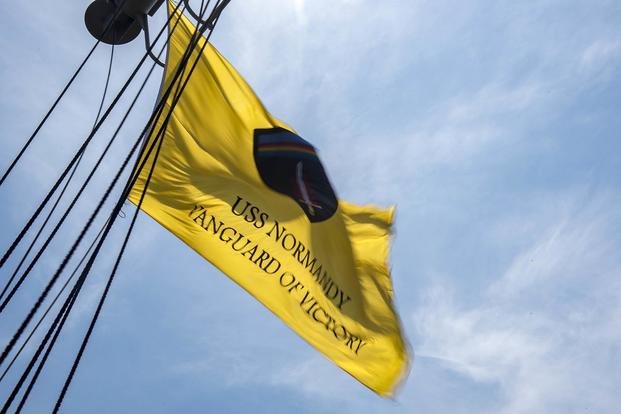
The Ticonderoga-class guided missile cruiser USS Normandy is named for the Battle of Normandy during World War II, which saw the Allies launch a massive invasion of France. The ship's motto of "Vanguard of Victory" appears emblazoned across a yellow flag with a sword and shield above it. The ship's motto "underscore[s] the Battle of Normandy as the spearhead of the Allied defense which turned the tide of war in Europe," according to the Navy. The sword and shield are in fact the insignia for the Supreme Headquarters Allied Expeditionary Forces (SHAEF), which was then-Gen. Dwight D. Eisenhower's command starting in 1943 and whose staff was responsible for planning Operation Overlord.
USS O'Kane
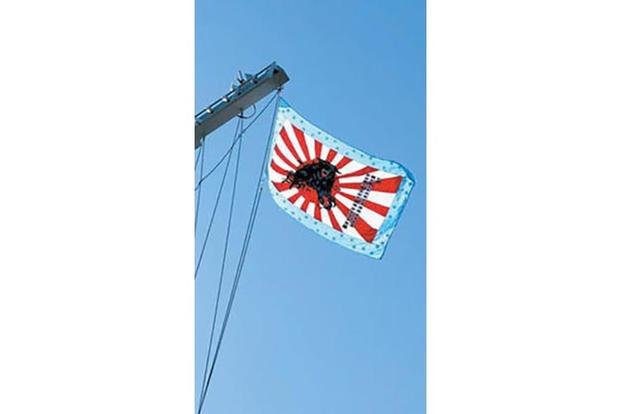
Commissioned in 1998, the USS O'Kane was named for Rear Adm. Richard O'Kane, who received the Medal of Honor for commanding the Balao-class submarine USS Tang to the most successful record of any submarine in history during World War II. As a result, the Arleigh Burke-class guided missile destroyer flies a replica of the "Battle Cat" war flag -- a black "battle cat" bursting from the middle of a rising sun -- that the Tang flew during its successful wartime patrols, complete with distinct victory markings that denote the submarine's record 33 kills against Japanese vessels during the conflict.
USS Paul Hamilton

The Arleigh Burke-class destroyer USS Paul Hamilton is known for its distinct "Moultrie Flag," which features a white crescent with the word "LIBERTY' emblazoned across a blue background. The flag was designed by South Carolina state militia commander Col. William Moultrie, who gained fame across the nascent United States in 1776 for successfully defending the strategically important Sullivan's Island during a 10-hour siege by the British Royal Navy. Moultrie would present his flag to Gen. Nathanael Greene as "the first American Flag displayed in the South" during the liberation of Charleston in 1782, according to historians, and a version of the banner would go on to become the official state flag of South Carolina.
USS Paul Ignatius
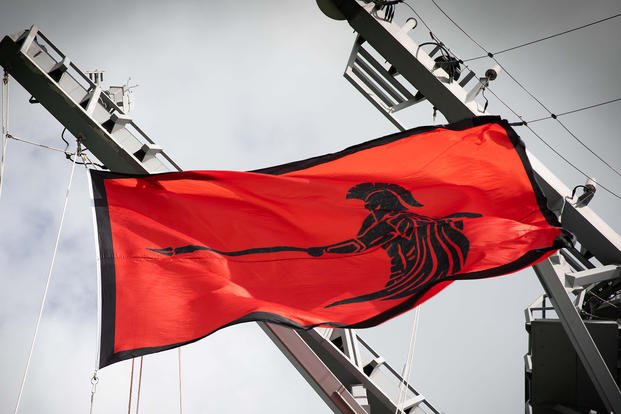
The USS Paul Ignatius is one of the Navy's newest destroyers, and its battle flag is relatively spartan -- sort of. Named for former secretary of the Navy (and World War II lieutenant) Paul Ignatius, the Arleigh Burke-class destroyer's battle ensign features a black silhouette of the Spartan warrior. Although the significance of the symbol is unclear, it may be a tribute to the "Trojans" of Ignatius' alma mater, the University of Southern California, which also inspired the ship’s crest.
USS Preble
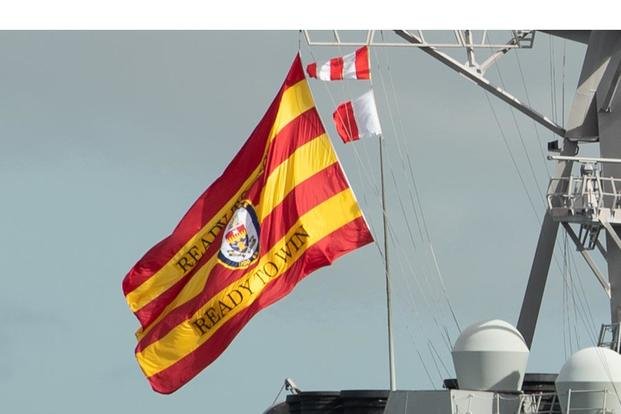
The USS Preble's battle ensign is as simple as it gets, featuring the slogan "READY TO FIGHT, READY TO WIN" emblazoned across red and yellow horizontal stripes with the ship's crest in the dead center of the banner. Named for Revolutionary War naval officer Commodore Edward Preble, it's worth noting that the Arleigh Burke-class destroyer's motto is actually "Intrepid Patriot," so it's unclear where the "Ready to Fight, Ready to Win" slogan originated.
USS Rafael Peralta
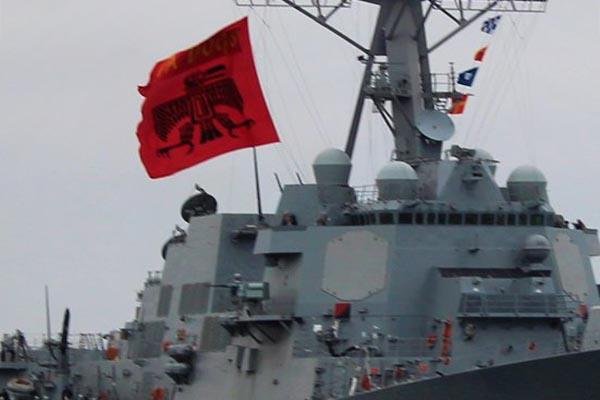
Named for Marine Sgt. Rafael Peralta, who gave his life to save his fellow Marines by jumping on a grenade during the Second Battle of Fallujah during the Iraq War, the Arleigh Burke-class destroyer flies a unique red battle flag in honor of its namesake. The flag features an Aztec war eagle as a tribute to Peralta's Aztec heritage and the words "LAVA DOGS'' emblazoned across the top to represent the 1st Battalion, 3rd Marines, to which Peralta belonged.
USS Ralph Johnson

The Arleigh Burke-class destroyer USS Ralph Johnson's battle flag centers on what the Navy describes as a "Vietnamese dragon" against a field of white below a single golden star. The dragon "is associated with water and is considered to have authority over life and death. Dragons are responsible for rain, without which life could not continue," according to the service's description of the symbol in the ship's crest, noting that the star "signifies the life [Marine Pfc.] Ralph Johnson saved that earned him the Medal of Honor" during the Vietnam War.
USS Ramage
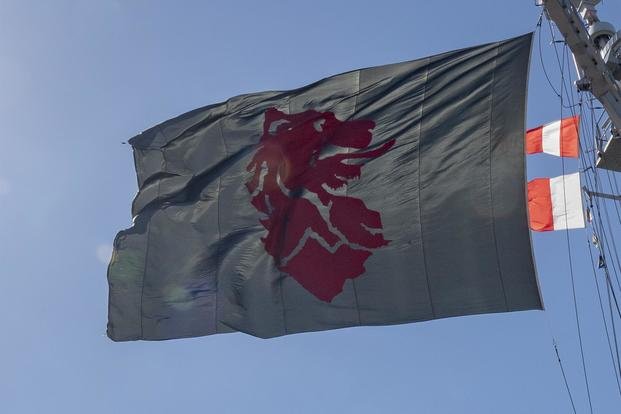
The USS Ramage is named for Vice Adm. Lawson "Red" Ramage, the noted World War II submarine commander. The Arleigh Burke-class destroyer's battle ensign consists of a red lion across a gray field, a symbol borrowed from the ship's crest.
USS Ronald Reagan

Named for the beloved former president, the USS Ronald Reagan aircraft carrier's battle flag features twin sabers crossed over the number 76 on a red-and-white field, as well as the letter B and the number 322. According to the Navy, the twin sabers represent Reagan's cavalry experience, while the B and 322 stand for Troop B, 322nd Cavalry, the unit which Reagan called his own when he enlisted in the Army in 1937. The golden 76, of course, refers to the carrier's hull number.
USS Ross
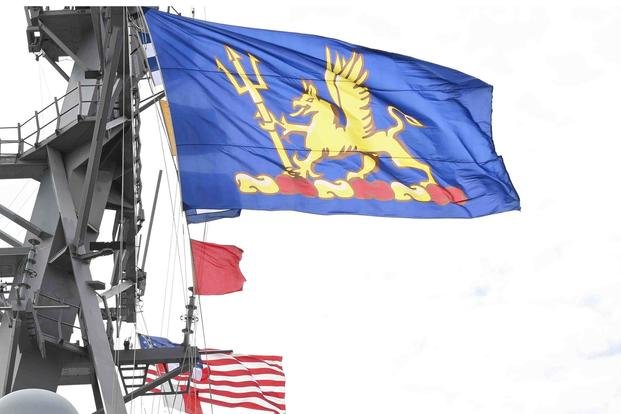
Named for Medal of Honor recipient Donald K. Ross, the Arleigh Burke-class destroyer USS Ross flies a battle flag featuring a golden griffin clasping a trident against a field of blue, a symbol pulled directly from the ship's crest. "The griffin, noted for vigilance, intelligence and valor, reflects the versatility of Ross' operating capabilities," according to the Navy. "It holds a trident denoting the range of Ross' offensive equipment and outstanding firepower."
USS Spruance

Named for World War II-era Adm. Raymond A. Spruance, the Arleigh Burke-class destroyer's battle flag features a simple phrase: "Launch the Attack." According to the Navy, this was the order Spruance issued to sailors when the storied Task Force 16 under his command located its first Japanese aircraft carriers on the morning of the Battle of Midway in June 1942. The three numerals in the center of the flag represent the ship's hull number, 111; it's unclear exactly what the four stars represent, other than Spruance's status as a four-star admiral during the war. Interestingly, this isn't the only "Launch the Attack" flag in the warship's inventory, according to DVIDS.
USS Sterett

The USS Sterett's battle flag is, apart from the USS Carl M. Levin, the second-known Navy battle flag to feature a phoenix, which appears in a plume of red, orange and yellow flames against a dark blue background. Named for legendary Master Commandant Andrew Sterett, the Arleigh Burke-class destroyer is the fourth Navy warship to bear the name, following a tradition of warships that saw action in World Wars I and II, as well as the Vietnam War. "In ancient Greek folklore, the phoenix is a bird that cyclically regenerates or is born again. A phoenix obtains new life by arising from the ashes of its predecessor," according to the Navy. "Due to [the] Sterett’s rich warfighting history of resiliency and perseverance under fire, this image of a phoenix was created to properly capture these sentiments and honor the former crews of their namesake."
USS Stockdale
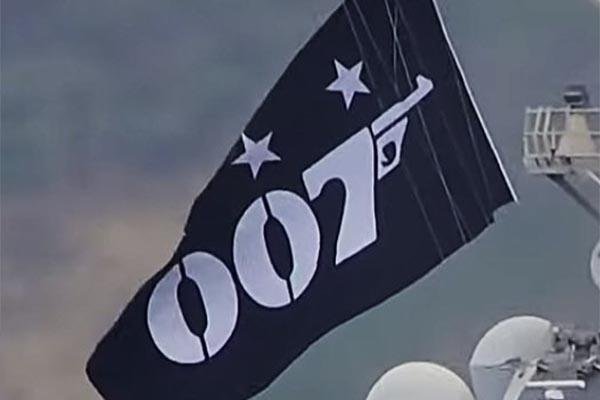
The Arleigh Burke-class destroyer USS Stockdale may have one of the newer (and cooler) battle flags in the fleet. Named for Vice Adm. James Bond Stockdale, the warship was recently spotted flying a "007" flag as a clear tribute to the "Bond" in its namesake's full name. The Stockdale had previously flown the POW/MIA flag at sea to honor Vice Adm. Stockdale's time as the most senior naval officer held captive in North Vietnam during the course of that conflict.
USS Stout

The USS Stout’s battle flag is among one of the simpler designs featured in the Navy fleet. The Arleigh Burke-class destroyer’s ensign features the ship's crest emblazoned against a blue background. The crest itself consists of a double-headed battle ax from namesake Adm. Herald F. Stout’s family coat of arms that “underscores Stout's massive firepower and high survivability … [and] alludes to the all-encompassing offensive and defensive power of the integrated AEGIS combat system,” per the Navy; a star representing Stout's combat awards, the Navy Cross and Silver Star; and a wedge piercing the field of a shield, representing Stout’s naval force “disabling and destroying a surface force of superior fire power” during combat in the Solomon Islands and Bougainville Island during World War II.
USS The Sullivans
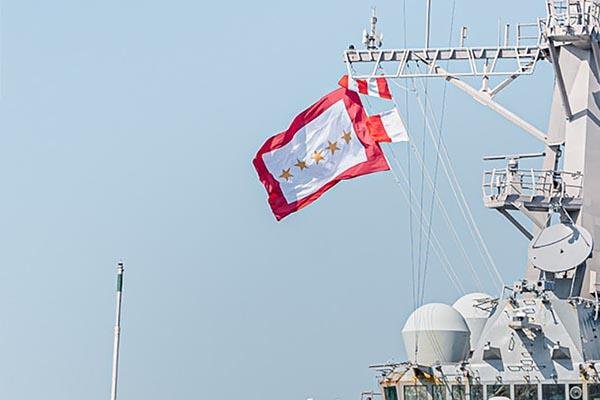
Named for the five brothers who were killed in action together aboard the light cruiser USS Juneau during World War II, the battle flag for the Arleigh Burke-class destroyer USS The Sullivans features five gold stars against a white background with a red border. The red in particular is "emblematic of courage and sacrifice," according to the Navy.
USS Wayne E Meyer
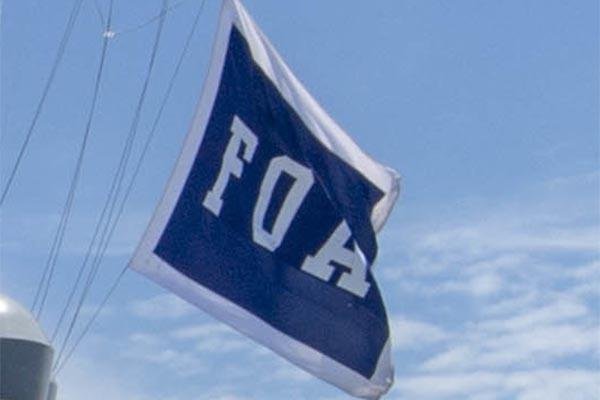
The Arleigh Burke-class destroyer flies a simple blue battle flag with the letters "FOA" emblazoned on it in white. Those letters stand for "Father of Aegis," a title bestowed on ship namesake Rear Adm. Wayne E. Meyer for spending years midwifing the vaunted Aegis Combat System that's a fixture of the Navy's current surface fleet.
USS Wichita
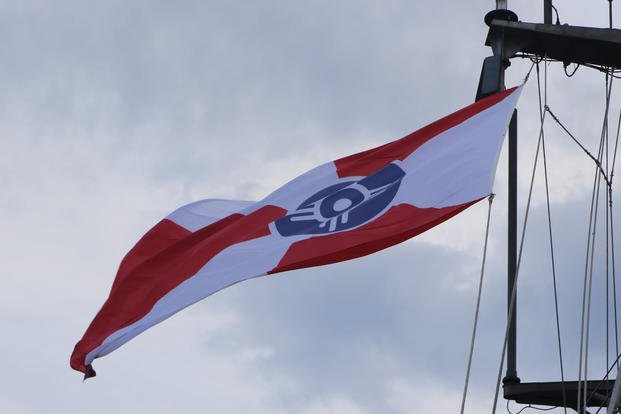
The third ship in the Navy named for the largest city in Kansas, the Freedom-class littoral combat ship USS Wichita boasts its namesake city’s official flag as its battle ensign.
Want to Learn More About Military Life?
Whether you're thinking of joining the military, looking for post-military careers or keeping up with military life and benefits, Military.com has you covered. Subscribe to Military.com to have military news, updates and resources delivered directly to your inbox.
